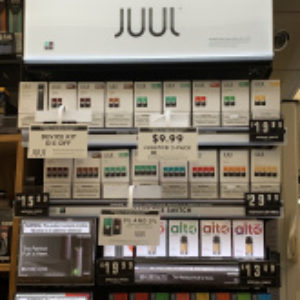Welcome to CounterTobacco.org’s “News and Research Roundup!” Each month we post a summary of the latest research, reports, and news stories on counteracting tobacco product sales and marketing at the point of sale (POS). Keeping up with what’s happening in the POS movement all across the country can help you choose policies and strategies that work best for your community. New research can help provide support for your work and evidence for the importance of the “War in the Store.” Have a story you don’t want us to miss? E-mail it to us!
New Research
Menthol and Other Flavored Tobacco Products
- Modelling retailer-based exemptions in flavoured tobacco sales restrictions: national estimates on the impact of product availability, BMJ
- This cross-sectional analysis was designed to understand changes to theUS retail environment for flavored tobacco products (FTP) that would occur if there were a hypothetical national
 tobacco control policy that prohibited FTP sales in all retailers except (1) tobacco specialty stores or (2) tobacco specialty stores and alcohol outlets. The study found that exempting tobacco specialty stores along would leave FTPs in 8.2% of retailers nationwide, while exempting both tobacco specialty stores and alcohol outlets would leave FTPs in 17.4% retailers. On average, the percent remaining FTP availability per 100,000 total population would be 7.1% for a tobacco specialty store exemption and 18.1% for a tobacco specialty store and alcohol outlet exemption. Compared with the national average, FTP availability would remain 47%–49% higher for all racial/ethnic groups in large metropolitan areas.
tobacco control policy that prohibited FTP sales in all retailers except (1) tobacco specialty stores or (2) tobacco specialty stores and alcohol outlets. The study found that exempting tobacco specialty stores along would leave FTPs in 8.2% of retailers nationwide, while exempting both tobacco specialty stores and alcohol outlets would leave FTPs in 17.4% retailers. On average, the percent remaining FTP availability per 100,000 total population would be 7.1% for a tobacco specialty store exemption and 18.1% for a tobacco specialty store and alcohol outlet exemption. Compared with the national average, FTP availability would remain 47%–49% higher for all racial/ethnic groups in large metropolitan areas.
- This cross-sectional analysis was designed to understand changes to theUS retail environment for flavored tobacco products (FTP) that would occur if there were a hypothetical national
- The impact of menthol flavoring in combusted tobacco on alternative product purchasing: A pilot study using the Experimental Tobacco Marketplace, Drug Alcohol Depend.
- This study examined the choices of menthol smokers using an online tobacco storefront called the Experimental Tobacco Marketplace. Researchers manipulated prices of menthol cigarettes and the availability of menthol little cigars and cigarillos (LCCs) to understand implications on demand and product substitutions. Findings showed that as the price of menthol cigarettes increased, demand for menthol cigarettes decreased and demand for combusted and non-combusted products increased, indicating significant substitution for menthol cigarettes.
- Evaluating tobacco retailer experience and compliance with a flavoured tobacco product restriction in Boston, Massachusetts: impact on product availability, advertisement and consumer demand, Tobacco Control
- Researchers aimed to understand the impact of Boston’s policy restricting the sale of flavored tobacco products, including cigars, smokeless tobacco, and e-cigarettes, to adult-only retailers. Between January and December 2016, data were collected in 488 retailers in Boston at baseline and 469 retailers at 8-month follow-up, measuring the type, brand, and flavor of tobacco products being sold. After policy im
 plementation, only 14.4% of youth-accessible retailers sold flavored products compared with 100% of retailers at baseline. Flavored tobacco product advertisements decreased from being present at 58.9% of retailers to 28.0% at follow-up. Retailers reported that educational visits and the flavored product guidance list aided with compliance.
plementation, only 14.4% of youth-accessible retailers sold flavored products compared with 100% of retailers at baseline. Flavored tobacco product advertisements decreased from being present at 58.9% of retailers to 28.0% at follow-up. Retailers reported that educational visits and the flavored product guidance list aided with compliance.
- Researchers aimed to understand the impact of Boston’s policy restricting the sale of flavored tobacco products, including cigars, smokeless tobacco, and e-cigarettes, to adult-only retailers. Between January and December 2016, data were collected in 488 retailers in Boston at baseline and 469 retailers at 8-month follow-up, measuring the type, brand, and flavor of tobacco products being sold. After policy im
Pricing Policies
- Cigarette taxes, prices, and disparities in current smoking in the United States, SSM- Population Health
- This study used a large, nationally representative dataset collected between 2003-2015 to examine associations between cigarette taxes and prices with smoking behavior. Researchers found that as cigarette taxes increased, smoking in the overall U.S. population decreased, but this association was small and not statistically significant except for theyoungest adult group (25-39 years). For this age group, smoking rates decreased more than in the general population as cigarette taxes increased. The researchers also found no significant association between the average state retail price for cigarettes and smoking. However, when examining associations between the price individuals report to have actually paid for cigarettes, researchers found that as self-reported prices of cigarettes increased, smoking rates decreased at a statistically significant level. Researchers hypothesize that the limited impact of taxes on smoking behavior could be a result of price discounts or coupons offsetting tax increases or shoppers purchasing across state borders, in Native American reservations, online, or switching to cheaper products. The study suggests that establishing and enforcing minimum floor prices for cigarettes, not modifiable byretailer or manufacturer discounts, would help keep prices high and increase the probability that people who smoke experience an unavoidable increase in cost as a result of a tax increase.
- The impact of e-cigarette and cigarette prices on e-cigarette and cigarette sales in California, Prev Med Rep
- This study was designed to estimate the impact of e-cigarette and cigarette prices on e-cigarette and cigarette sales in California. When prices of disposable e-cigarettes, reusable e-cigarettes, and cigarettes increased by 1%, per capita sales of the products decreased by 0.37%, 0.20%, and 0.21% respectively. As cigarette prices increased, per capita sales of reusable e-cigarettes increased, indicating reusable e-cigarettes are substitutes for cigarettes. Similarly, as reusable e-cigarette prices increased, per capita sales of disposable e-cigarettes increased, indicating disposable e-cigarettes are substitutes for reusable e-cigarettes. Results suggest that raising prices of disposable e-cigarettes, reusable e-cigarettes, and cigarettes using strategies such as tobacco excise tax increases would result in reduced sales for the products.
- Estimating the price elasticity of demand for JUUL E-cigarettes among teens, Drug and Alcohol Dependence
 Using the results of an experimental auction where teen nicotine users and nonusers bid on a JUUL kit, researchers estimated the price elasticity of demand. The study recruited 300 18- and 19-year old students to bid on 10 various tobacco products. Results indicated that a 10% increase in price leads to as much as a 24% reduction in JUUL demand among teens using nicotine, and as much as a 45% reduction among teens not currently using nicotine. The teens in this study were more price sensitive than older adults who took part in a similar previous study.
Using the results of an experimental auction where teen nicotine users and nonusers bid on a JUUL kit, researchers estimated the price elasticity of demand. The study recruited 300 18- and 19-year old students to bid on 10 various tobacco products. Results indicated that a 10% increase in price leads to as much as a 24% reduction in JUUL demand among teens using nicotine, and as much as a 45% reduction among teens not currently using nicotine. The teens in this study were more price sensitive than older adults who took part in a similar previous study.
Disparities
- Racial/Ethnic Disparities Across Indicators of Cigarette Smoking in the Era of Increased Tobacco Control, 1992- 2019, Nicotine & Tobacco Research
- News Story: Long-term data shows racial & ethnic disparities in effectiveness of anti-smoking measures, EurekAlert!
International
- Is the tobacco ‘footfall’ argument justified for tobacco purchases in New Zealand convenience stores?, Tobacco Control
Tobacco 21
- Tobacco 21 adoption decreased sales of cigarette brands purchased by young people: a translation of population health survey data to gain insight into market data for policy analysis, Tobacco Control
- This analysis aimed to capture the effect of Tobacco 21 policies on the cigarette sales of brands that are disproportionately purchased by youth. Using Nielsen Scantrack data covering January 2015 to October 2019, data showed sales of disproportionally young brands declined after Tobacco 21 implementation.
Other
- Associations of tobacco retailer availability with chronic obstructive pulmonary disease related hospital outcomes, United States, 2014, Health & Place
- While previous research has identified an association between tobacco retailer density and smoking behavior, little research has examined the relationship between tobacco retailers and smoking-related health problems. This study used cross-sectional data from 2014 to investigate the relationships between tobacco retailer density and chronic obstructive pulmonary disease (COPD) related outcomes in a sample of 1510 counties across the United States. Higher retailer density was associated with a 19% higher COPD-related hospital discharge rate and 30% higher total COPD-related hospital costs per population.
Industry News
- FDA Authorizes Sale of the IQOS 3 Tobacco Heating System Device in the United States, Business Wire
- Total Nicotine Volume Up as Pantry Loading Increases, CSP Daily
POS Policy in the Media
E-Cigarettes
Tobacco 21
- [MN] Commissioners OK T21 tobacco ordinance, The Journal
Menthol and Other Flavored Tobacco Products
- [MT] Missoula bans sale of flavored vape products; lawsuit threatened, Montana Public Radio
- National Medical Association (NMA) joins AATCLC, AMA and ASH in lawsuit against the FDA
- California is set to ban menthol cigarettes on Jan. 1. The industry is out to stop it, The Sacramento Bee
- Banning menthol cigarettes doesn’t appear to be FDA priority entering 2021, Winston-Salem Journal
Tobacco Retailer Licenses
- [MD] Liquor Board may get some tobacco enforcement duties, Herald-Mail Media
- [CA] Board Approves Tobacco Retail Licensing Program, San Diego County News Center
Health Warnings
- Tobacco manufacturers gain additional time to implement graphic warning labels, Winston-Salem Journal
Other
- [AK] Anchorage Assembly moves to include vaping, e-cigarette products in tobacco tax, Alaska Public Media
- Indiana lawmakers eyeing cigarette tax hike to reduce Hoosier smoking rate, The Times
- [CA] Survey says Colusa County needs a better balance of healthy and accessible products in stores, Colusa County Sun-Herald
- [MA] Tobacco-Free Generation: Brookline passes new restriction aiming to phase out tobacco sales to young smokers, com
- [NY] Attorney general cracks down on shops illegally selling e-cigarettes & flavored vaping products
Find more stories in last month’s News and Research Roundup.
Know of a story that we missed? Email us, and we’ll be sure to include it in next month’s roundup!


